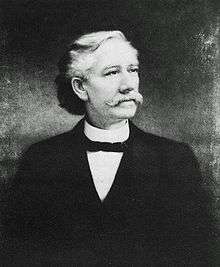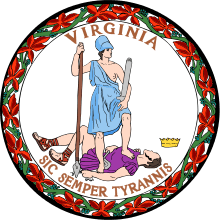Charles Triplett O'Ferrall
| Charles Triplett O'Ferrall | |
|---|---|
 Portrait of Governor O'Ferrall | |
| 42nd Governor of Virginia | |
|
In office January 1, 1894 – January 1, 1898 | |
| Lieutenant | Robert Craig Kent |
| Preceded by | Philip W. McKinney |
| Succeeded by | James Hoge Tyler |
| Member of the U.S. House of Representatives from Virginia's 7th district | |
|
In office May 5, 1884 – December 28, 1893 | |
| Preceded by | John Paul |
| Succeeded by | Smith S. Turner |
| Member of the Virginia House of Delegates from Rockingham County | |
|
In office 1872–1873 Alongside George Deneale | |
| Personal details | |
| Born |
October 21, 1840 Berkley Springs, Virginia |
| Died |
September 22, 1905 (aged 64) Richmond, Virginia |
| Political party | Democratic |
| Alma mater | Washington College |
| Profession | Politician, Lawyer |
| Military service | |
| Allegiance |
|
| Service/branch | Confederate States Army |
| Years of service | 1861–1865 |
| Rank | Colonel |
| Battles/wars | American Civil War |
Charles Triplett "Trip" O'Ferrall (October 21, 1840 – September 22, 1905) was a Virginian politician who served as a U.S. Representative from 1883 to 1894 and the 42nd Governor of Virginia from 1894 to 1898.
Early life and career
Charles O'Ferrall was born in Bath, Virginia (now Berkeley Springs, West Virginia) to John and Jane Laurens Green O'Ferrall. His father was an innkeeper and former member of the Virginia General Assembly who was elected Clerk of Court of Morgan County in 1851. When John O'Ferrall died suddenly in 1855, the local judge thought highly enough of Charles O'Ferrall to appoint the fifteen-year-old to hold the post until an election could be held.[1] He was sufficiently respected to later win election, at the age of seventeen, to a full six-year term as Clerk of Court. However, he only served less than half the term before the county was thrown into upheaval by the outbreak of the civil war.[2]
Despite coming from a predominantly pro-Union area, O'Ferrall felt his true allegiance to be to Virginia, and he thus joined the Confederate side of the war.[3] Enlisting as a cavalry private, O'Ferrall was immediately offered the position of sergeant.[4] He subsequently distinguished himself in several battles, leading to his advancement to the rank of major and his being allowed to form his own cavalry battalion.[5] By the end of the war, O'Ferrall was a colonel in command of all cavalry in the Shenandoah Valley, and his regiment engaged in the last fight of the war on Virginia soil.[6] All told, he had been wounded eight times in battle, including once so seriously that he was left for dead.[1]
Entry into state politics
After the war, O'Ferrall returned to the family tradition of inn keeping, though he found this both personally and financially unfulfilling.[1] Accordingly, he decided to instead pursue a law degree at Washington College, graduating in 1869 and starting a law practice in Harrisonburg. However, he quickly returned to politics by successfully running for the Virginia House of Delegates in 1871, and unsuccessfully for the U.S. Congress the next year.[7] In 1874, the General Assembly appointed O'Ferrall as a county judge. However, he found the duty tedious and returned to the practice of law at the end of his six-year term.[8]
After several years of practicing law and assisting various Democratic candidates, O'Ferrall challenged John Paul for Virginia's 7th congressional district in 1883. The initial election vote count showed O'Ferrall down by 200 votes (out of 24,000), but he contested the result and eventually won the seat.[8] O'Ferrall subsequently won reelection five times, serving ten years in the House of Representatives. His congressional career was largely unremarkable, though he did gain a reputation as a staunch advocate for Virginia and of President Grover Cleveland.[9]
Governor
After two failed attempts to gain the Democratic nomination for governor, O'Ferrall determined to make a strong push in 1893.[10] He was able to gain the support of the Democratic organization and easily won the nomination. The Republicans decided not to contest the election, so O'Ferrall's only opponent was Populist Party candidate Edmund Cocke who he defeated with 59.71% of the vote.[11] O'Ferrall benefited from fears of populism and negro supremacy to win election with the largest majority that any Virginia governor had ever received.[12]
The first half of O'Ferrall's term as governor was highlighted by his willingness to use strong measures to preserve law and order. He dispatched armed forces to protect nonstriking miners and maintain peace during a miners' strike and also to drive Coxey's "army" of protest marchers out of the state.[13] Despite his public stance as a white supremacist, O'Ferrall was also quick to send troops to break up mob violence and prevent lynchings.[14] His actions thus defused several high-profile situations, and he remained a generally popular governor through the end of 1895.[15]
In 1896, the politics of the Democratic party were dominated by the issue of bimetallism and "Free Silver", alienating O'Ferrall who had always been a staunch advocate of the gold standard. The silver issue culminated in the selection of William Jennings Bryan as the Democratic 1896 presidential candidate.[16] As a result, O'Ferrall became one of a small group of Virginia Democrats who supported the gold standard and opposed Bryan's candidacy.[17] This stand undermined O'Ferrall's popularity and political support, and ensured that he would be a lame duck with no significant political accomplishments for the remainder of his term as governor.[18]
Electoral history
- 1884; O'Ferrall was elected to the U.S. House of Representatives with 56.37% of the vote, defeating Republican Joseph B. Webb.
- 1886; O'Ferrall was re-elected with 51.71% of the vote, defeating Independent Democrat John E. Roller.
- 1888; O'Ferrall was re-elected with 54.32% of the vote, defeating now-Republican Roller and Populist John C. Rivercombe.
- 1890; O'Ferrall was re-elected with 89.25% of the vote, defeating Republican I.M. Underwood.
- 1892; O'Ferrall was re-elected with 64% of the vote, defeating Populist John Lewis.
Departure from politics and death
O'Ferrall's opposition to the silver issue not only undermined the last years of his governorship, but also effectively lead to his retirement from public life.[19] He subsequently attempted a return to the practice of law, but his practice was undermined by significant health issues, partly the result of the wounds he had suffered during the Civil War.[20] In 1904, he published his autobiography, titled Forty Years of Active Service. Shortly after its publication, O'Ferrall died on September 22, 1905 in Richmond Virginia, and was buried in the Hollywood Cemetery.[7] His personal papers are held by the Special Collections Research Center at the College of William & Mary.[21]
References
- 1 2 3 Weisiger, Minor T. (1982). Edward Younger, ed. The Governors of Virginia, 1860-1978. University Press of Virginia. p. 135. ISBN 0-8139-0920-1.
- ↑ O'Ferrall, Charles Triplett (1904). Forty Years of Active Service. The Neale publishing company. pp. 183–184. ISBN 0-7222-8280-X.
- ↑ O'Ferrall (1904) p. 185
- ↑ O'Ferrall (1904) pp. 21–22
- ↑ O'Ferrall (1904) pp. 86-87
- ↑ Frank H. Gille (ed.). The Encyclopedia of Virginia 1999; Volume One. Somerset Publishers. p. 182. ISBN 0-403-09753-3.
- 1 2 "Biographical Directory of the United States Congress: O'FERRALL, Charles Triplett, (1840 - 1905)". United States Congress. Retrieved 2007-12-17.
- 1 2 Weisiger (1982) p. 137
- ↑ Weisiger (1982) pp. 137–138
- ↑ Weisiger (1982) p. 138
- ↑ Tice Moore, James. "Edmund R. Cocke (1841–1922)". Encyclopedia Virginia. Retrieved 29 June 2015.
- ↑ Moger, Allen (1968). Virginia: Bourbonism to Byrd, 1870-1925. University Press of Virginia. pp. 109–111. OCLC 435376.
- ↑ Moger (1968) pp. 154–155
- ↑ Weisiger (1982) p. 141
- ↑ Weisiger (1982) p. 142
- ↑ Weisiger (1982) p. 143
- ↑ Moger (1968) p. 161
- ↑ Weisiger (1982) pp. 143–144
- ↑ Moger (1968) p. 165
- ↑ Weisiger (1982) p. 145
- ↑ "Charles Triplett O'Ferrall Papers". Special Collections Research Center, Earl Gregg Swem Library, College of William & Mary. Retrieved 4 February 2011.
External links
-
 Media related to Charles Triplett O'Ferrall at Wikimedia Commons
Media related to Charles Triplett O'Ferrall at Wikimedia Commons - Finding aid for the Charles Triplett O'Ferrall Papers
- A Guide to the Executive Papers of Charles T. O'Ferrall, 1894-1897 at The Library of Virginia
- Works by or about Charles Triplett O'Ferrall at Internet Archive
| United States House of Representatives | ||
|---|---|---|
| Preceded by John Paul |
Member of the U.S. House of Representatives from Virginia's 7th congressional district 1884–1893 |
Succeeded by Smith S. Turner |
| Political offices | ||
| Preceded by Philip W. McKinney |
Governor of Virginia 1894–1898 |
Succeeded by James Hoge Tyler |
